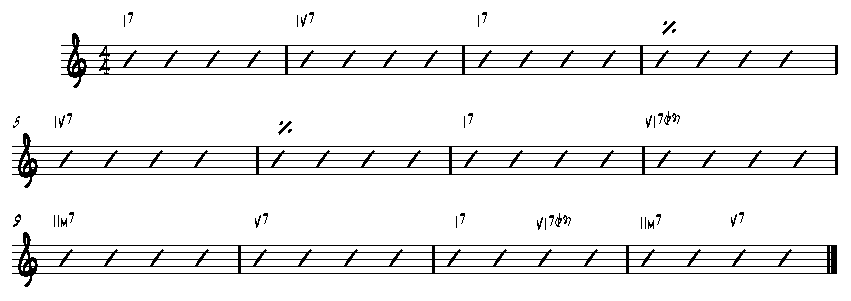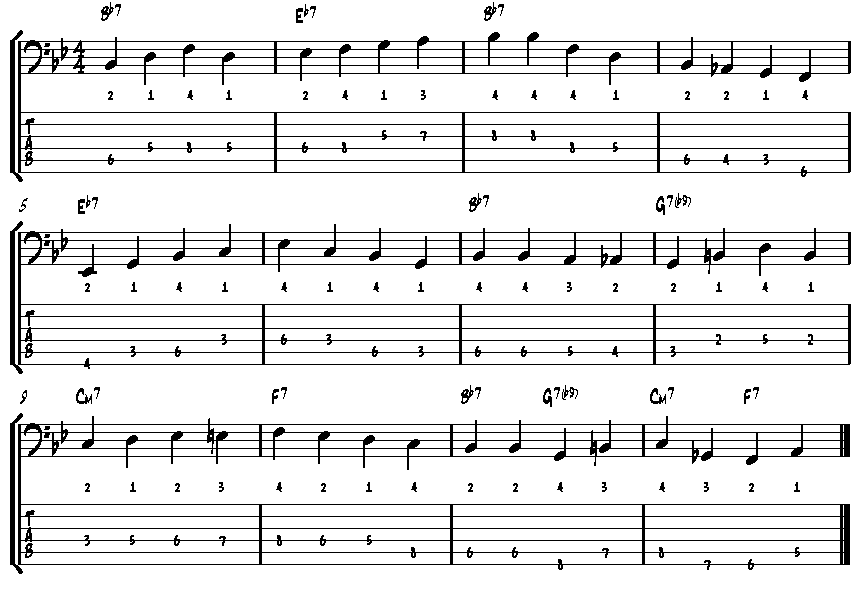Since the lessons portion of Sputnik Music is down and being rearranged, I'm just going to post this lesson here, at least for now. Enjoy!
Tapping out a jazz blues on the 6-string bass
By Adam Neely
NOTE: It is advised that you have at least rudimentary grasp on jazz music and performance theory before you attempt to master the concepts taught in this lesson.
Two-handed touchstyle technique affords for the six-string bassist a vast array of possibilities for performance and study. No longer confined to crude polyphony involving plucking out triads and diads, the six-string bassist can perform pieces in counterpoint, greatly opening up the musical palette. But once the basics of technique are mastered, where does one go? What sort of stylistic approach can be mastered? Refined and elegant recitations of baroque fugues and inventions? Driving and percussive funk grooves that incorporate other techniques like slapping and thumbing? Or perhaps comping chords and walking basslines to be a one-man jazz machine?
Hopefully we’ll get to all of that, but for now, we’ll focus on that last option. In this lesson, we’ll go over the basics of being a one-man rhythm section, and how the concept of both playing chords and walking a bassline can be applied to both solo and group play. We’ll first study one chorus of a jazz blues realized for six-string bass, and then begin to improvise lines. Contrapuntal improvisation is a difficult technique to get under our belts, but if those dam
ned piano players can do it, than we sure can as well.
First, let’s take a look at jazz blues. The jazz blues chord progression is the most common progression in all of jazz. Countless melodies have been written off the numerous variations of the basic chord progression, and any jazz player worth his salt will be able to tear up a solo on these changes at the drop of a hat. Jazz blues is different than regular blues in that it takes a much more ii-V-I approach to harmony, and will often approach chords in a different manner. For those who do not know what a typical jazz blues looks like, here is a chord chart.

It is a fairly simple and straightforward chord progression, which is great for our purposes, and it yields a plethora of melodic ideas for solos and melodies, which explains why it is such a popular progression used by jazz artists the world over.
The first step in building the chorus our jazz blues is to come up with a walking line. Walking the bass is a familiar concept to bassists, so this part won’t be so difficult, but there are some key differences between tapping a walk and plucking a walk. First, when tapping a walk, open strings aren’t going to be used at all, and so considerations must be made. The familiar, lower positions for walking lines normally make full use of open strings, and so in order to compensate for this lack of utility, tapped walks must be performed several positions up. Second, one must “ration” strings for walking in order not to have conflict of interests between the two hands. Generally speaking, the majority of your walking should be planned around the B, E and A strings so as to leave the rest of the strings for the right hand’s performance. The D string can (and should) be used occasionally, but always keeping in mind that the right hand might require a note here and there for extensions. Chords only really need two notes to be jazz chords – the third and the seventh – but in order to add flavor, a third tension tone can be added, which is exactly how conflict could arise on the D string. We’ll get more into this later.
When walking a bassline with traditional pluck method, we can afford much more brainpower for various intricacies including performing lines without playing the root, chromatic movements, playing in extreme ranges, etc. We don’t quite have that luxury with playing tapped lines and having chordal movement on top. We’ll need to keep it pretty much as basic as possible, at least at first. This means triadic movement is essential, as well as the memorization of very basic patterns to be recalled at the drop of a hat. Improvising can be thought of as completely making something up as one goes along, but from a pragmatic standpoint, improvising walking lines is more piecing together different parts of the puzzle that you already have. This should be what you think of when you approach tapped walks, and any walking line in general for that matter.
OK, lets get started. Here’s a basic line that we can work with for the purposes of the lesson. You can make up one of your own in the basic styling of this one, remembering the concepts introduced thus far. Tab is provided, as well as fingerings. We’ll be doing this jazz blues in Bb, because that is essentially the standard key for jazz due to the way horns are tuned.

Note that the bulk of the playing occurs on the B, E and A strings with a brief foray onto the D string in measures two and three. Also note that this is just a realization of a walking line, and there are many more. We’re working with this non-improvised line just for study purposes. When you play, it’ll be improvised.
We now have a base from which to work (no pun intended). Where do we go from here? Chords, of course. When playing in a jazz combo, the pianist, or possibly the guitarist, will be responsible for providing the harmonic extrapolation to the bassline that the bassist provides. Like walking lines, there is an entire art to “comping”, or improvising chords within the context of a rhythm section. Guitarists and pianists will provide a textural support for the soloist, both rhythmically and harmonically. With a six-string bass, we can approach this art form (albeit in a very rudimentary fashion) and apply it to a walking line that we ourselves provide with two-handed tapping. This opens a range of possibilities to solo play, and performing in an ensemble that doesn’t have the luxury of a chordal instrument. It also gives bassists even
more control over the direction of a performance.
When comping, the majority of the performance should take place on the G and C strings in order to keep the lower strings available for walking. Like we covered earlier, the majority of chords will only need two tones to be chords - the third and the seventh. The third is necessary because it governs whether or not a chord is major or minor, and the seventh is necessary because it gives the chord function within a jazz chord progression as a dominant, subdominant, tonic, etc. You’ll be covering the root of the chord in your left hand with your walking bassline, so its not of any concern to the right hand, and the fifth generally is considered a weak note for the chord, unless it is altered somehow, so it will likely be ignored. Essentially, this should all boil down to you punching out diads with your right hand.
Let’s test this with playing the chord tones in the right hand against the walking line we already came up with. Note that the “b9” in the G7 in measure 8 and measure 11 isn’t a necessity for the progression, so it will be omitted in the chord voicings for now.

Well…OK…it sounds good enough, I guess. But it definitely doesn’t sound like you’re making music, it sounds pretty dry. Jazz is a very rhythmic genre, and as such, you want as much rhythm happen as possible. Comping, like walking, is as much a rhythmic performance technique as it is a harmonic performance technique, and so careful consideration to the rhythms one plays while comping is extremely important. No pianist or guitarist will ever play whole notes over ever change in the progression, and neither should you when you are comping.
What should you do, then? Well, I like to think of jazz (and all forms of music, really) as a language, and as someone who is speaking the language, it would be prudent to be versed in the vocabulary of the language. Jazz has a lot of common syncopated rhythms that you can use for your comping, some of which can be found below. Go through each one and play the example that we just went through using the same rhythm for every measure.

(cont.)